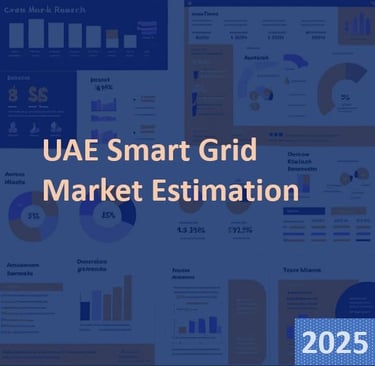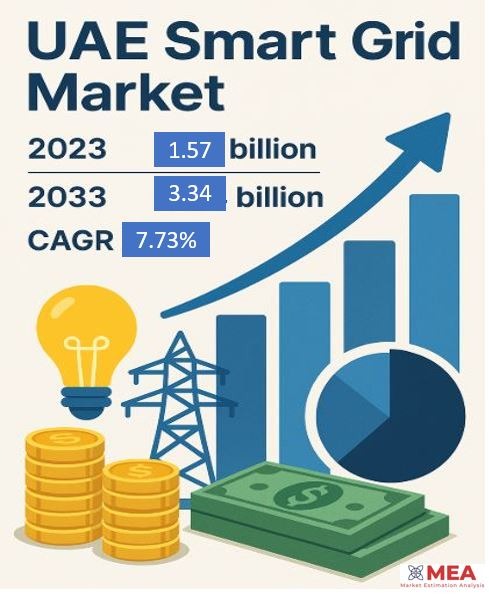

United Arab Emirates (UAE) Smart Grid Market (2025-2033)
Only Excel
The Excel covers estimation with respect to the UAE Smart Grid market Forecast and is Segmented by Technology (Transmission, Communication Technology, Advanced Metering Infrastructure (AMI), and Other Technologies), Component (Hardware, Software, and Services), and End-User (Residential, Commercial, Industrial, Utilities, and Government)
Historical Year: 2021-2023 | Base Year: 2024 | Forecast Year: 2025-2033
Market Overview
Smart grid technologies in the UAE are redefining how electricity is generated, distributed, and consumed. Moving away from legacy systems, these intelligent networks enable two-way communication between utilities and consumers, offering enhanced control, predictive analytics, and greater energy transparency.
One of the standout players in this transformation is the Dubai Electricity and Water Authority (DEWA), which is spearheading the emirate’s vision of becoming the world’s smartest city. Through its AED 7 billion (USD 1.9 billion) Smart Grid Programme, DEWA is laying the foundation for a next-generation infrastructure aligned with its 100% clean energy goal by 2050.
Some major advancements include:
Deployment of over 2 million smart meters equipped with automatic reading capabilities.
Expansion of a robust RF mesh communication network connecting 4,200+ substations.
Implementation of a Virtual Power Plant (VPP), combining distributed solar inverters, residential PV systems, and EV charging stations.
Energy storage pilots using sodium sulphide and lithium-ion batteries at the Mohammed bin Rashid Al Maktoum Solar Park.
Market Dynamics and Growth Prospects
The UAE Smart Grid market size reached US$1.57 Billion in 2023. MEA (Market Estimation Analysis) expects the market to reach US$3.34 Billion by 2033, exhibiting a growth rate (CAGR) of 7.73% during 2025-2033.
The UAE Smart Grid market is entering a transformative phase, propelled by the country’s ambitious clean energy goals, rapid urbanization, and commitment to digital innovation. As power demands soar due to industrialization and a growing population, the nation is reimagining its electricity infrastructure by deploying intelligent grid systems that leverage next-gen technologies.
Under the umbrella of long-term strategies like the UAE Energy Strategy 2050 and the Dubai Clean Energy Strategy 2050, the government is accelerating smart grid adoption to ensure a sustainable, efficient, and reliable energy future. These initiatives highlight the nation’s dedication to achieving energy efficiency and environmental sustainability through an optimal energy mix, with a growing reliance on renewable sources.
Investments in grid modernization and digitization are fueling the sector, setting the stage for a smart energy ecosystem that balances supply and demand through automation, real-time monitoring, and data-driven decision-making.
Key Market Trends Shaping the Industry
Integration of Renewable Energy Sources
The UAE is steadily transforming its energy sector by incorporating renewable sources such as solar and wind into the national electricity network. As global priorities shift toward cleaner power, smart grid systems are playing a vital role in maintaining energy balance, supporting better grid control, and improving storage capabilities. The government’s renewable energy targets include achieving 25 percent clean power by 2030 and reaching full transition to renewables by 2050. With the growth of distributed energy resources (DERs), the country is moving toward a more decentralized grid, which allows for greater flexibility, efficiency, and resilience in energy distribution.
Advanced Metering Infrastructure (AMI) Development
Advanced Metering Infrastructure, or AMI, is a key enabler of the UAE’s shift to a smarter energy ecosystem. AMI allows utilities to collect and analyze energy usage data in real time through a secure communication network and integrated IT systems. DEWA has taken significant strides in implementing this technology across Dubai, including secure communication systems, a centralized head-end platform, and a comprehensive meter data management solution linked to its billing system. As of 2021, more than one million smart electricity meters and close to one million smart water meters had been deployed across the city. These meters help consumers monitor and control their energy and water consumption, promoting more efficient resource usage.
Technological Advancements in Grid Management
The UAE's smart grid landscape is evolving through the adoption of cutting-edge technologies such as artificial intelligence and machine learning. These innovations are being used to predict system faults, detect energy theft, and forecast consumption trends. DEWA has introduced AI through its "iService" platform, which identifies meter tampering and provides real-time insights into the performance of the grid. In addition, DEWA has developed a new software tool called Smart Design of Electricity Distribution Networks (SDEDNs). This platform integrates existing databases with electrical network layouts, allowing engineers to design smarter, more reliable power infrastructure.
Decentralization and Distributed Energy Resources
The increasing adoption of distributed energy resources like rooftop solar panels, wind turbines, and battery storage systems is driving the decentralization of the UAE's power grid. DEWA is leading this transformation through its virtual power plant, which brings together various renewable sources to create a unified and flexible grid system. The number of DEWA-managed EV charging stations has risen from 100 in 2015 to 325 as of 2022. This expansion supports the national target of increasing electric and hybrid vehicle adoption to 20 percent by 2025 and 30 percent by 2030. DEWA is also investing in forward-looking technologies such as vehicle-to-grid systems, autonomous electric vehicles, ultra-fast chargers, mobile charging units, and wireless charging infrastructure.
Segmentation and Market Insights
MEA provides an estimation of each segment of the UAE Smart Grid market, along with forecasts at the country level from 2025-2033. Our excel has categorized the market based on technology, component and end-user.
By Technology
Transmission & Distribution: Enabling real-time control over power flow across long distances.
Communication Technologies: Supporting seamless data exchange between grid components for accurate monitoring and automation.
Advanced Metering Infrastructure (AMI): Allowing two-way data communication and empowering energy consumers.
Other Technologies: Including microgrids, battery energy storage, and distributed generation systems that boost grid flexibility.
By Component
Hardware: Involving smart meters, sensors, PMUs, and energy storage devices.
Software: Covering Supervisory Control and Data Acquisition (SCADA) systems, billing solutions, and AI-powered analytics for operational optimization.
Services: Including consulting, installation, system integration, and lifecycle maintenance.
By End-User
Residential: Homes benefiting from personalized energy insights and reduced bills.
Commercial: Businesses optimizing operations and improving sustainability metrics.
Industrial: Factories and plants using smart grids to enhance uptime and reliability.
Utilities: Power providers leading digital transformation for improved service delivery.
Government: Public sector bodies driving national strategies and infrastructure upgrades.
Get Accurate Forecasts and Data
Our meticulously designed Excel sheet provides detailed forecasts and estimations for the UAE Smart Grid market. With segmentation across technology, component and end-user, our data enables businesses to identify opportunities, analyze trends, and strategize effectively in this dynamic market.
Competitive Landscape
The UAE Smart Grid market is moderately consolidated with notable contributions from local utilities and global tech leaders. Here's a snapshot of the companies shaping the sector:
Dubai Electricity and Water Authority (DEWA): A pioneer in smart grid rollouts, DEWA has led major AMI deployments, virtual power plant projects, and smart infrastructure investments worth billions.
Eaton.: Offering energy automation and its innovative EnergyAware UPS system to reduce peak energy costs and improve power reliability.
Schneider Electric SE: Collaborating on sustainable smart city initiatives and microgrids to empower vulnerable communities and enhance resilience.
General Electric (GE): Focusing on grid-forming PV inverter technologies to better accommodate high solar loads across the network.
Korea Electric Power Corporation (KEPCO): Actively supports UAE smart grid development through pilot projects and technology integration.
Abu Dhabi Distribution Company (ADDC): Strengthening the emirate’s energy efficiency through strategic AMI rollouts and renewable integration.
Sharjah Electricity and Water Board (SEWA): Investing in smart metering and grid automation to enhance Sharjah’s energy network reliability and sustainability.


Why the UAE Smart Grid Market Matters
The transformation of the UAE’s power sector into a smart, connected, and resilient grid represents a cornerstone of the nation’s journey toward sustainability and energy independence. With robust government backing, forward-thinking utilities, and cutting-edge technologies in place, the UAE Smart Grid market is set to be a regional benchmark for innovation, environmental stewardship, and digital excellence.
SEGMENTS COVERED
By Technology
Transmission
Communication Technology
Advanced Metering Infrastructure (AMI)
Other Technologies
By Component
Hardware
Software
Services
By End-User
Residential
Commercial
Industrial
Utilities
Government
